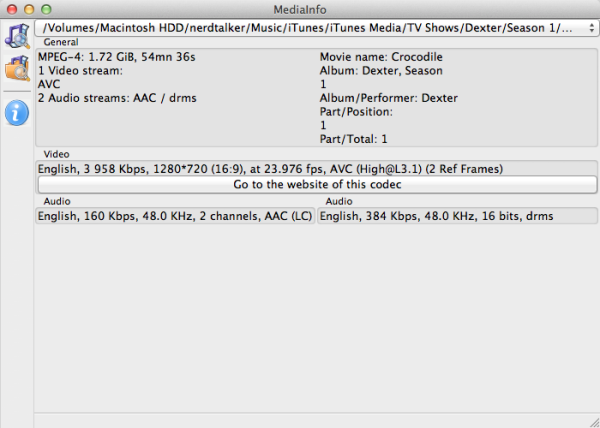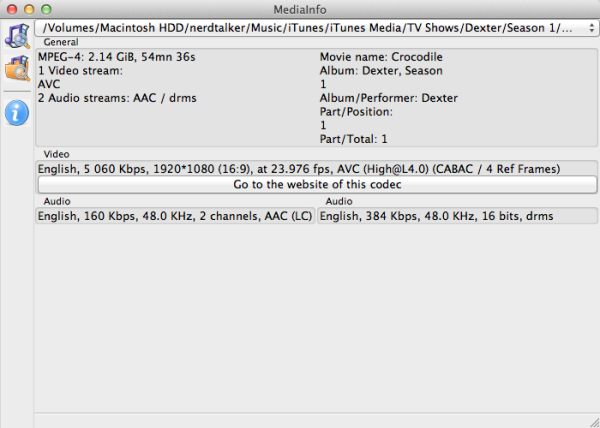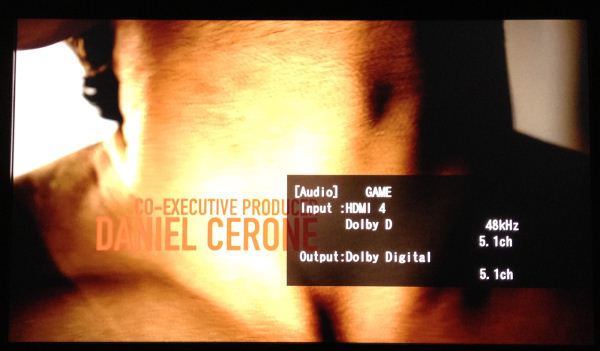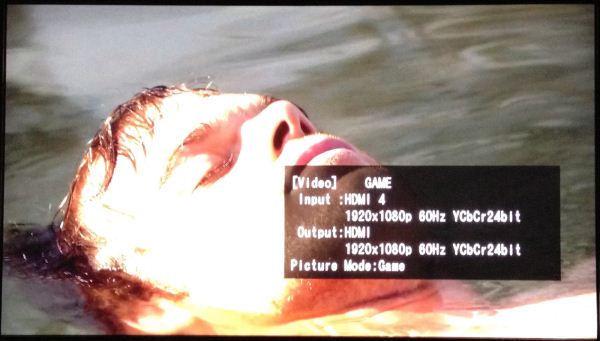Apple TV 3 (2012) Short Review - 1080p and better WiFi
by Brian Klug on March 21, 2012 4:21 PM ESTApple's two goals with the Apple TV 3 refresh seem to be - improved wireless connectivity, and of course support for 1080p content. We've touched on the first one, and the second one we touched on with the single core A5. Going from the single core Cortex A8 A4 to a single core Cortex A9 in the A5R2 might not seem to make much sense superficially, 20% increase in IPC aside, until you realize there are other things inside an SoC than CPU and GPU. I'm talking about the video decode blocks, which no doubt the primary reason for the change in SoC. Both the A4 and A5 use Imagination's PowerVR VXD (D for Decode, VXE is E for encode) family of encoders and decoders. The A4 used a PowerVR VXD375, and the A5 uses a more powerful VXD decoder.
That difference in SoC allows the Apple TV 3 to decode 1080p30 H.264 at a higher profile than the A4-based Apple TV 2. Apple outlines their H.264 decode capabilities as shown in the table below:
| Apple TV 2 and 3 - Decode | |||||||
| Apple TV 3 (A5) (BCGA1427) | Apple TV 2 (A4) (BCGA1378) | ||||||
| Format | Max Decode Parameters | ||||||
| H.264 | H.264 video up to 1080p, 30 frames per second, High or Main Profile level 4.0 or lower, Baseline profile level 3.0 or lower with AAC-LC audio up to 160 Kbps per channel, 48kHz, stereo audio in .m4v, .mp4, and .mov file formats | H.264 video up to 720p, 30 frames per second, Main Profile level 3.1 with AAC-LC audio up to 160 Kbps per channel, 48kHz, stereo audio in .m4v, .mp4, and .mov file formats | |||||
| MPEG-4 | MPEG-4 video up to 2.5 Mbps, 640 by 480 pixels, 30 frames per second, Simple Profile with AAC-LC audio up to 160 Kbps, 48kHz, stereo audio in .m4v, .mp4, and .mov file formats | MPEG-4 video, up to 2.5 Mbps, 640 by 480 pixels, 30 frames per second, Simple Profile with AAC-LC audio up to 160 Kbps, 48kHz, stereo audio in .m4v, .mp4, and .mov file formats | |||||
| MJPEG | Motion JPEG (M-JPEG) up to 35 Mbps, 1280 by 720 pixels, 30 frames per second, audio in ulaw, PCM stereo audio in .avi file format | Motion JPEG (M-JPEG) up to 35 Mbps, 1280 by 720 pixels, 30 frames per second, audio in ulaw, PCM stereo audio in .avi file format | |||||
Unsurprisingly these decode parameters are very close to the iPad 2 / iPhone 4S which carry A5R1 (H.264 High Profile up to Level 4.1), so we can know for sure that A5R2 inherits a similar decode block at least. Moving to a better decoder allows the device to decode video which has been encoded with more H.264 features as well, and thus achieve higher encoder efficiency.
I've touched on this before but bitrate and file size doesn't grow much between the 720p and 1080p encodes of the same media for iTunes content. I fired up MediaInfo and took a look at the 720p and 1080p copies of the same episode of Dexter freshly downloaded from iTunes.

iTunes 720p30 - 4 Mbps H.264 High@L3.1 with 2 Reference frames

iTunes 1080p30 - 5 Mbps H.264 High@L4.0 with CABAC and 4 Reference frames
Unsurprisingly the 1080p30 iTunes video uses the maximum encode parameters for the A5 SoC with H.264 Level 4.0. They've also gone for CABAC and 4 reference frames, which makes these 1080p encodes much more efficient in terms of quality / bit than the 720p encodes. 5 Mbps is still a bit low even with these encode parameters for 1080p where the typical guidance is around 10 Mbps. No doubt the bitrate of your lowest common denominator cable ISP is the limitation here, and unfortunately Apple currently lacks the infrastructure to stream different 1080p bitrates and encodes.
While the bump up to H.264 high profile and inclusion of CABAC and 5 reference frames makes iTunes' 1080p encodes eerily similar to Blu-ray in features, the lower bitrate results in quality which simply isn't close. Videophiles will definitely be able to tell the difference between Apple's 1080p content and Blu-ray.
Apparently the 25% larger file size isn't enough to warrant additional NAND either, as again the Apple TV 2 and 3 still include 8 GB for caching iCloud Photo Stream content and iTunes media locally.
Just like before, the only video output option is HDMI, where the Apple TV 3 lets you go up to 1080p at 50 or 60 Hz. Audio output continues to be over HDMI or a full size TOSLINK. Apple TV continues to also output Dolby Digital 5.1 if the source content offers it.
I don't remember there being SXGA, XGA, and SVGA options in the previous builds of Apple TV, but as of the latest 5.0 (Build 4099) update these options are also now available for selection if you're interested in running the device with a non 16:9 aspect ratio display.
It goes without saying that running the Apple TV 3 at its native resolution on a 1080p display results in much better looking everything (UI, navigation, and media) than it did with the 720p model. Obviously upscaling 720p on a 1080p display resulted in a less than satisfactory experience, but made Apple TV 2 very suited to smaller 720p displays.
The Apple TV 3 doesn't seem strained drawing the UI at 1920x1080, in fact the 2.25x increase in pixel count doesn't seem to have slowed down the interface at all. There were a few areas that always seemed to drop frames on Apple TV 2 (namely the album art flip on the currently playing screen, one which continually nagged me every time it happened) which simply don't drop frames anymore, thank goodness. The only place I ever encounter lag is the related video YouTube picker which appears at the end of a video, where both the Apple TV 2 and 3 stutter, and a few edge cases. For example, trying to do much of anything the first time you enable iTunes Match seems to particularly strain the single core A9 in the A5R2. Outside that however, Apple TV 3 seems pretty performant, and doesn't disappoint when actually playing back media.












37 Comments
View All Comments
nfineon - Wednesday, March 21, 2012 - link
This is exactly the review I was hoping to find, with a more technical explanation of the hardware underpinnings that Apple doesn't really care to advertise. I personally have 6 Apple TV's throughout the house in all the key rooms and we get tremendous usage out of the Apple TV. Sitting at the dinner table together being able to instantly share our photos and videos via airplay is very nice, but a lot of people also don't realize that you can facetime on the big screen using the airplay mirroring function (try FaceTime on a 100" Projector/LCD and your mother won't ever want to use the small screen again).It's good to hear the antenna gain as improved, and i was really really hoping they would bump up to 2 spacial streams to get us 130 mb/s as Airplay of 1080p videos takes 2-3 times longer to load from the iPhone 4s camera as compared to the traditional 720p. That would also necessitate a bump up in all the iPad/iPhone devices as well given that all of them are also limited to 65 mb/s.
But the #1 usage of the Apple TV's in our house is in streaming our movie/show collection from our Synology NAS in any format. You can't do this with the default firmware, which is why we use the FireCore firmware that keeps the same interface and functions as the original Apple TV while adding the ability to stream from any network device in any format. Also lets you install XBMC, plex and a few other handy tools if you want to go the extra mile but that alone has made the Apple TV increase in value considerably!
Brian Klug - Thursday, March 22, 2012 - link
I was hoping for 2 spatial stream WLAN connectivity as well, unfortunately it just isn't here yet.No doubt future revisions of the Apple TV will use either BCM43241 (which is 2x2:2 and dual-band), instead of the direct BCM4330 successor, BCM4334 (which is still 1 spatial stream, but built on 45nm instead of 4330's 65nm).
-Brian
Shaun-T - Thursday, March 22, 2012 - link
What I want to know is, why doesn't Apple allow the refresh rate to be 24fps on the Apple TV 3? I read somewhere that the Apple TV 2 only output at 25 or 30fps as 720p/24 wasn't an official standard, but 1080p/24 is.So now we have a device that supports 1080p and the content sold on iTunes is 1080p/24. As BluRay players and and modern HD televisions use this, I don't understand why the the Apple TV 3 only outputs at 25 or 30fps. In either of those refresh rates, you get a stutter every second or so when playing 24fps content. It's really annoying.
MGSsancho - Thursday, March 22, 2012 - link
This device is not for what apple calls videohpines who wan to play BD ISOs, DVD ISOs and the llike. It is designed to play anything found on iTunes. If you can get other stuff to play then that is just the gravy on top. For things that are actully useful (at least on current offerings) we are forced to jailbreak it. :)cjs150 - Friday, March 23, 2012 - link
What an incredible oversite (bit like Apple advertising the Ipad 3 as 4G in Europe when it is not).But given that Intel are/were (what is latest position) incapable of producing a chip which outputed at the correct frame rate either (unlike AMD) why should we be surprised.
BD frame rate are not exactly an obscure or new standard!
I guess I will just drop this off my list of things to buy at least until someone jailbreaks it and gets the right frame rate and XBMC on it
solipsism - Saturday, March 24, 2012 - link
Why doesn't Europe follow the ITU's definition of 4G?alpha64 - Friday, March 23, 2012 - link
Your comment in the third page, which reads:In addition, the Apple TV 3 also moves from Broadcom's BCM4329 802.11a/b/g/n and BT 2.0+EDR combo chip to BCM4330 802.11a/b/g/n and BT 4.0 combo chip which we've seen in the iPad 2, iPhone 4S, and countless other mobile devices.
Should say "we've seen in the iPad 3, iPhone 4S, ..."
The iPad 2 had the same BCM4329 as the iPad and iPhone 4:
http://www.ifixit.com/Teardown/iPad-2-Wi-Fi-Teardo...
jpcuve - Monday, March 26, 2012 - link
I purchased one too. Since the last upgrade it plays all my movies correctly (600+), with the subtitles.locust76 - Tuesday, March 27, 2012 - link
I have the new Apple TV and a 40-inch 1080p Sony LCD, and I definitely notice a new sharpness and realism to the images and video from iTunes.I think it's also worth mentioning what this thing can do outside of the iTunes ecosphere: I ripped the Star Wars Ep 4 Blu-Ray and compressed it down to iTunes-level specifications, but with almost 10 Mbit/s video bitrate and DD 5.1.
The Apple TV handled it with no problem, save for buffering issues which prevented me from skipping wildly throughout the movie without longer pauses. However, when the movie was playing, it played without stuttering with exceptional picture quality, considering I was running a video stream through it that was probably double Apple's intended bitrate...
kwrzesien - Wednesday, March 28, 2012 - link
Is this with wired Ethernet or Wi-Fi?